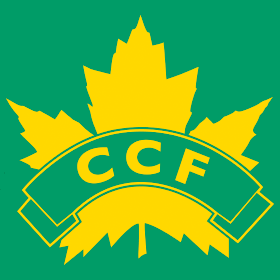Manitoba Cooperative Commonwealth Federation
|
Co-operative Commonwealth Federation (Manitoba)
|
|
|---|---|
 Former provincial political party |
|
| Founded | 1932 |
| Dissolved | 8 October 1961 Entered into a coalition with the Canadian Labour Congress to form the New Democratic Party of Manitoba |
| Headquarters | Winnipeg, Manitoba |
| Ideology | Social democracy, Democratic socialism, Agrarianism |
| Political position | Left |
| International affiliation | Socialist International |
| Colours | Green and Yellow |
The Cooperative Commonwealth Federation (Manitoba Section) (CCF), known informally as the Manitoba CCF, was a provincial branch of the national Canadian party by the same name. The national CCF was the dominant social-democratic party in Canada from the 1930s to the early 1960s, when it merged with the labour movement to become the New Democratic Party. The Manitoba CCF, created in 1932, played the same role at the provincial level.
It was initially a small organization, and was supported by members of the Independent Labour Party, which had existed in the province since 1920. The ILP and CCF were brought into a formal alliance in 1933, despite misgivings from some in the former party.
The ILP was the leading social-democratic party in Manitoba prior to the CCF's formation. It had a reliable support base in Winnipeg and other urban areas, but had virtually no organization in the countryside. The CCF was formed to bring labour and farm groups into the same political camp. Some ILP members saw this as diluting their party's integrity.
The provincial CCF had become stronger by 1936, and the ILP's candidates in that year's provincial election were referred to as "ILP-CCF". After the election, some disgruntled ILP members succeeded in temporarily disaffiliating the parties. Pressure from David Lewis and J. S. Woodsworth brought about a quick realignment, but relations remained strained.
At the start of World War II, the ILP and CCF were again in disagreement: the ILP supported an all-out war effort, whereas the CCF supported the conscription of "wealth rather than men".
This controversy contributed to the defeat of federal CCF MP Abraham Albert Heaps in the election of 1940.
The CCF eventually gained control of the ILP's internal organization, and the two parties were effectively one after 1941. The ILP formally disbanded in 1943.
In late 1940, the ILP-CCF accepted an offer by Manitoba Premier John Bracken to become part of an all-party "unity government". This decision was opposed by some national leaders (including David Lewis), but was supported by local figures such as Seymour Farmer, who had led the ILP parliamentary group since 1935. On November 4, 1940, Farmer became the first socialist politician in Canadian history to attain cabinet rank, having been sworn in as Minister of Labour.
...
Wikipedia
